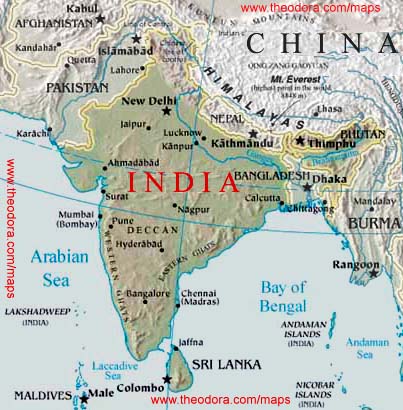
|
India, officially Republic of India, the second most populous country in the world, it is also sometimes called Bharat, its ancient name. India's land frontier (c.9,500 mi/15,290 km long) stretches from the Arabian Sea on the west to the Bay of Bengal on the east and touches Pakistan (W); China, Nepal, and Bhutan (N); Bangladesh, which forms an enclave in the northeast; and Myanmar (E). New Delhi is India's capital and Bombay (Mumbai) its largest city and commercial capital. India's Population as on 1st March 2001 stood at 1,027,015,247 persons, its total area 1,261,810 sq mi (3,268,090 sq km).
Although India occupies only 2.4% of the world's land area, it supports over 15% of the world's population. Almost 40% of Indians are younger than 15 years of age. About 70% of the people live in more than 550,000 villages, and the remainder in more than 200 towns and cities. Over thousands of years of its history, India has been invaded from the Iranian plateau, Central Asia, Arabia, Afghanistan, and the West; Indian people and culture have absorbed and changed these influences to produce a remarkable racial and cultural synthesis. Religion, caste, and language are major determinants of social and political organization in India today. The government has recognized 18 languages as official; Hindi is the most widely spoken. Although 83% of the people are Hindu, India also is the home of more than 120 million Muslims--one of the world's largest Muslim populations. The population also includes Christians, Sikhs, Jains, Buddhists, and Parsis. |
Introduction about Hyderabad
Hyderabad, the capital city of Andhra Pradesh is a
bustling 400-year-old metropolis with an urban population of 4.2 million people
approximately. Hyderabad is located on the Deccan Plateau and the Musi River,
650m above sea level. The physiography of Hyderabad is dominated by hills,
tanks, forests, and rock formations.
The Hyderabad city is cosmopolitan, and is richly endowed with a variety of
cultures. While Muslim people are concentrated more towards the old city like
Charminar, Secunderabad has got a more contemporary look with a concentration of
Anglo-Indians. The city of Hyderabad presents an attractive amalgam of old world
charm together with the ebullience of growth and enterprise. Beautiful old
edifices built in the medieval, Mughal, Colonial and Indo-Saracenic styles
abound, rubbing shoulders with large glass and chrome temples of commerce.
Tourist Attractions within Hyderabad
Charminar
|
|
A splendid piece of architecture standing in the heart of the city built by Quli Qutub Shah, in 1591. This magnificent monument is the unique symbol of Hyderabad . Charminar is often called as "The Arc de triomphe of the East". It is considered as the legendary masterpiece of Qutub Shahi's
Golconda Fort
|
|
Golconda fort of Andhra Pradesh, is a majestic monument, which lies on the western outskirts of Hyderabad city. It speaks of a great cultural heritage of 400 years and is regarded as a place worth visiting. Built by Mohammed Quli Qutub Shah in 1525, it stands as the epitome of Nawabi culture and grandeur. A new attraction at the fort is a sound and light show that brings the legend of Golconda to life. With a spectacular interplay of audio and visual effects, the story of Golconda unfolds over centuries of splendour. The show livens up the glorious past and it is an experience worth watching. The show is presented in English, Hindi and Telugu.
Mecca Masjid
|
|
Mecca Masjid is one of the largest mosques in India accommodating up to 10,000 worshippers. This is the biggest mosque in Hyderabad and lies within hundred yards to the southwest of Charminar. The mosque got its name from the belief that the bricks inserted over the central arch were baked out of clay brought from Mecca, and also from the grand mosque at Mecca on which it is patterned. The constructions of this mosque was started by Sultan Muhammad Qutub Shah, the work continued during the reign of Abdullah Qutub Shah and Abul Hassan Tana Shah and was completed in 1694 by the Mughal Emperor Aurangzeb.
Amaravati Travel
|
|
Amaravati is situated in Sattenapalli Taluk of Guntur District and it is famous as the seat of a temple to Lord Shiva worshipped here as Lord 'Amareswara' and also for the Buddhist sculptures, which are world famous. 'Amareswaram' is considered sacred because of three things, the Krishna River, an important Kshetra with a 'Sthalamahatyam' and the Sri Mahalinga Murthy, which are three sacred principles embodied in one.
Hussain Sagar Lake
|
|
A one of the largest man-made lakes in Asia, located in the heart of the Hyderabad City, contributing to its immense beauty. It is a sprawling artificial lake that holds water perennially. It was built during the reign of Ibrahim Qutub Shah in 1562, on a tributary of river Musi. The unique feature of this lake it connects the twin cities of Hyderabad and Secunderabad.
Kanaka Durga Temple
|
|
Kanaka Durga, goddess of power, riches and benevolence is considered the presiding deity of Vijayawada. The temple is set on the Indrakiladri hill. The deity in the Kanaka Durga temple is regarded as 'Swayambhu' or self-manifested, hence is considered very powerful. It is said that 'Adi Shankara' visited this temple and installed the 'Sri Chakra' here.